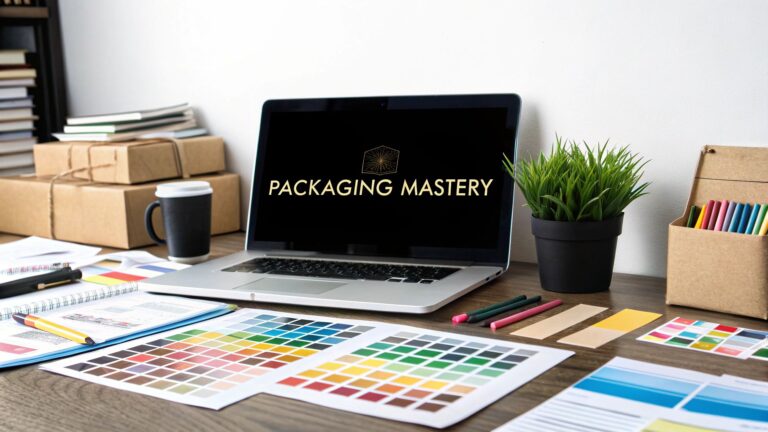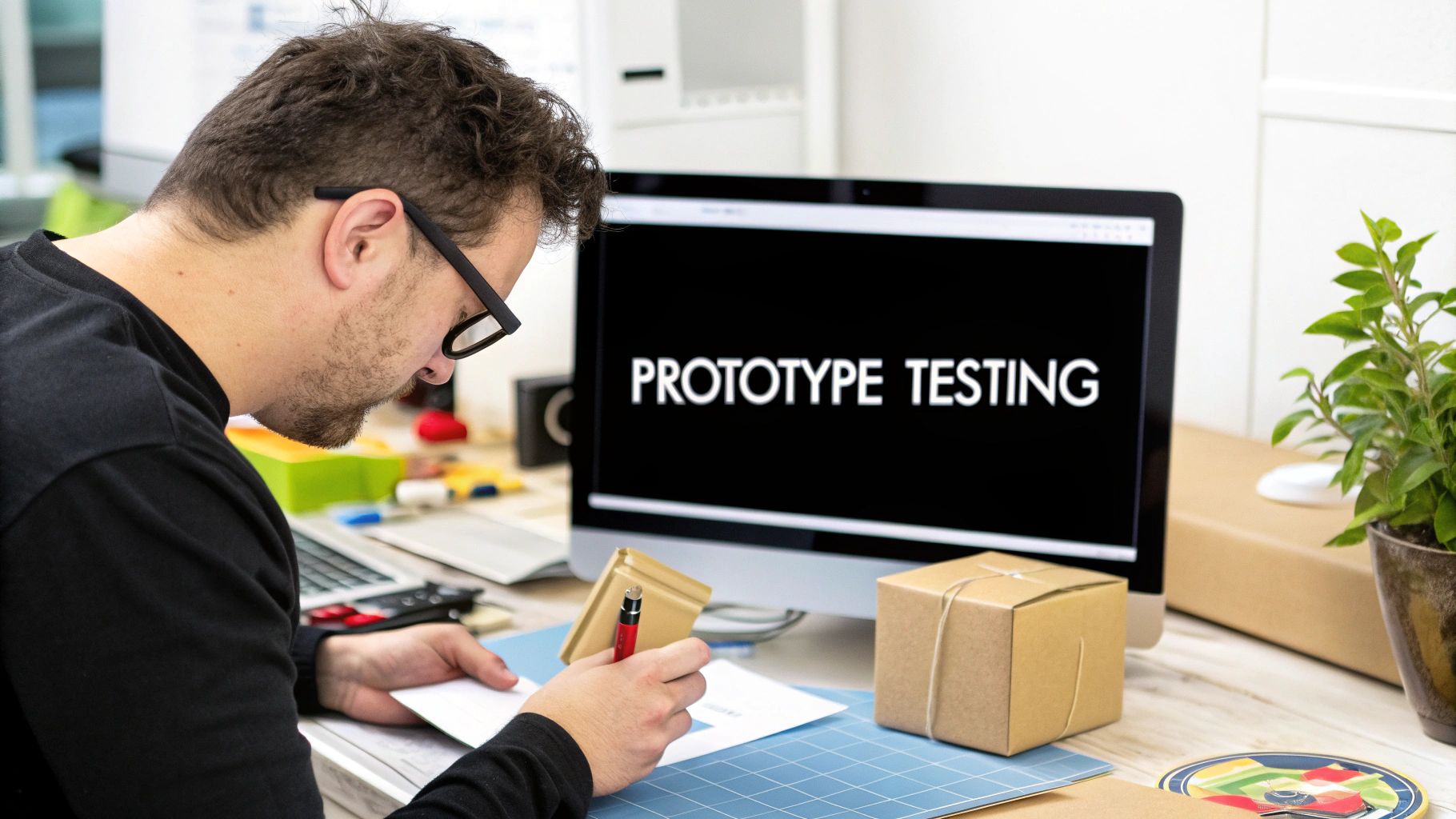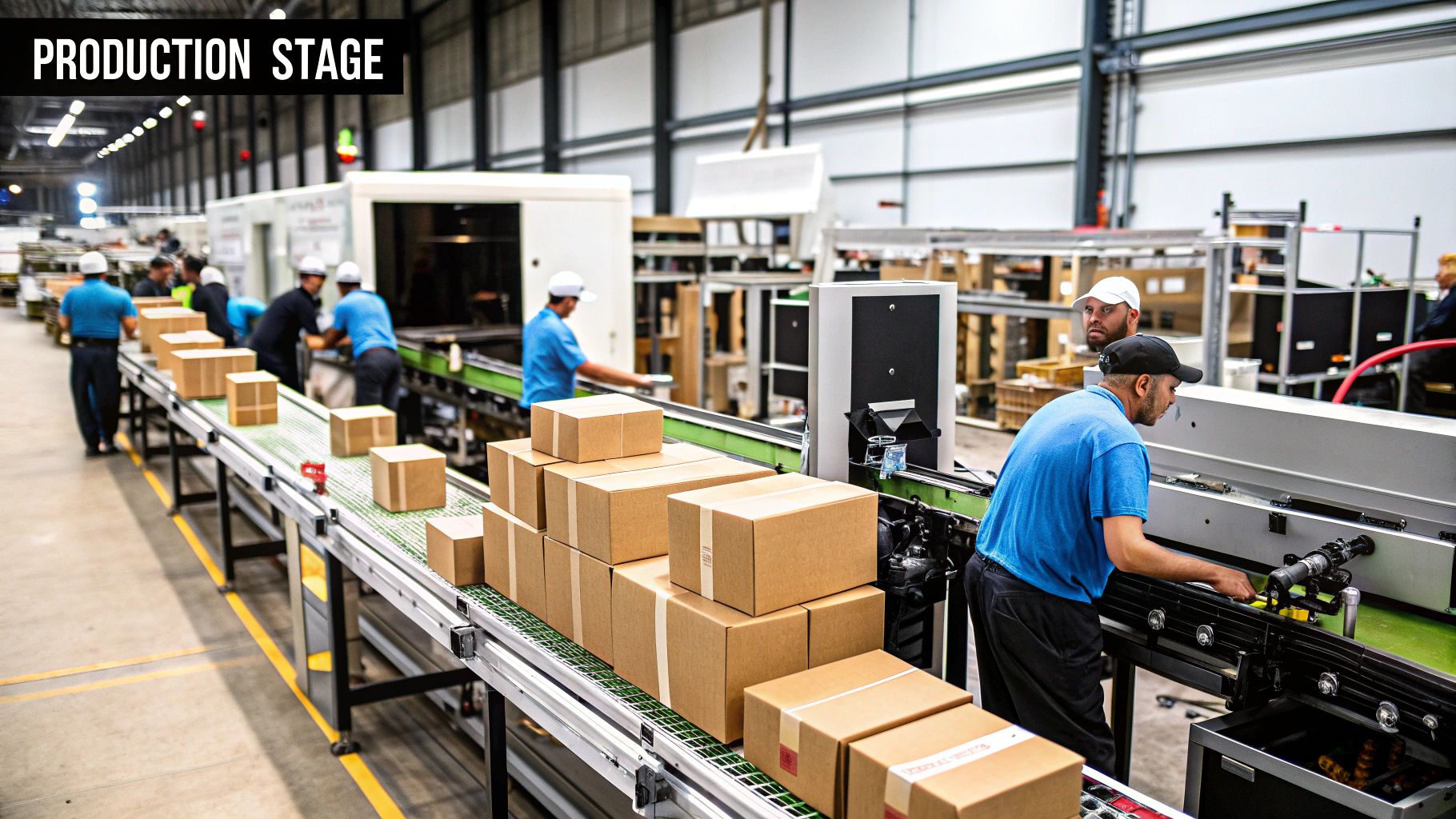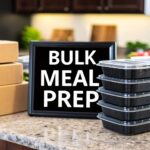The Fundamentals That Drive Packaging Success
Creating effective packaging is a strategic process that extends far beyond simply holding a product. It’s a multi-layered approach requiring a thorough understanding of brand identity, target audience, and current market trends. This packaging design process guarantees that the final product not only protects its contents but also effectively communicates the brand’s message and improves the customer’s experience.
Understanding the Packaging Design Workflow
The packaging design process, similar to constructing a building, necessitates a structured, step-by-step method. The process starts with the all-important briefing stage. This initial step involves defining the project’s scope, target audience, and overall goals. It sets the groundwork for the entire project, much like creating a blueprint.
Following the briefing stage is the research phase. Designers thoroughly investigate market analysis, competitor research, and consumer behavior studies. This is comparable to surveying the land and understanding the surrounding environment before building commences. For instance, understanding consumer preferences for sustainable packaging materials can significantly influence design decisions.
Furthermore, understanding competitor strategies helps pinpoint areas to set a brand apart. Market research provides invaluable data for making well-informed choices. Speaking of market growth, the packaging design services market was valued at USD 26.64 billion in 2025. It’s projected to reach USD 35.06 billion by 2032, demonstrating a CAGR of 4%. This growth underscores the increasing importance of packaging today.
Design, Development, Testing, and Production
Next, the process enters the design and development phase. This involves brainstorming, sketching, prototyping, and refining the selected design. Consider this the construction phase of our building analogy, where concepts become tangible objects. Feedback and revisions throughout this phase are crucial, guaranteeing the design aligns with the initial brief and practical factors like manufacturing feasibility.
To further illustrate the stages of the packaging design process, let’s take a look at the following table:
Key Stages of the Packaging Design Process
| Stage | Key Activities | Stakeholders Involved | Expected Outcomes |
|---|---|---|---|
| Briefing | Define project scope, target audience, and objectives | Client, Design Team | Clear project brief, agreed-upon goals |
| Research | Market analysis, competitor research, and consumer behavior studies | Design Team, Market Research Analysts | Understanding of market trends, consumer preferences, and competitor strategies |
| Design & Development | Brainstorming, sketching, prototyping, and design refinement | Design Team, Client | Functional and aesthetically pleasing packaging prototypes |
| Testing & Production | Quality assurance, functionality testing, safety testing, and manufacturing | Quality Control, Manufacturers, Client | Finalized packaging is ready for market launch |
This table highlights the key activities, stakeholders, and expected outcomes for each stage, emphasizing the collaborative and iterative nature of the design process.
Finally, the process concludes with testing and production. This stage involves rigorous testing to ensure the packaging adheres to quality, functionality, and safety regulations. This is akin to inspecting a completed building to confirm it’s structurally sound and fit for purpose. This meticulous process guarantees the finished product effectively communicates the brand message, appeals to consumers, and safeguards the product inside. The strength of this sequence rests in its logical progression. Each step builds upon the last, minimizing errors and maximizing the potential for creating truly effective packaging.
Research Strategies That Actually Inform Design
Effective packaging design begins with solid research. This goes beyond simply checking out the competition. It’s about truly understanding your target audience and the market as a whole.
Understanding Your Target Audience
Knowing your audience is crucial. This means understanding their demographics, lifestyle, and, most importantly, their packaging needs and frustrations.
For example, a younger audience might prioritize visually appealing and sustainable packaging, while older consumers might value functionality and ease of use.
Gathering this data can involve surveys, focus groups, and analyzing online behavior. This research allows you to create packaging that truly connects with your specific audience.
Competitive Analysis: Learning From the Market
Analyzing your competition offers valuable insights. The goal isn’t to copy, but to find opportunities to differentiate your product.
Observe what works for competitors and, more importantly, what doesn’t. This analysis informs your design choices, helping you create packaging that stands out and communicates your product’s unique value proposition.
Retail Environment Analysis
Understanding where your product will be sold is essential. Is it a supermarket, a boutique, or primarily online? The retail environment significantly impacts purchasing decisions.
For instance, brightly colored packaging might work well in a bustling supermarket, while a minimalist design could be more fitting for a high-end boutique. Consider the lighting, shelf placement, and surrounding products. These factors influence how customers perceive your packaging and help optimize your design for its intended retail setting.
Translating Research into a Design Brief
All this research culminates in a strategic design brief. This document guides the entire packaging design process. It outlines the key objectives, target audience insights, competitive analysis findings, and retail environment considerations.
A well-crafted brief provides clear direction for designers. This ensures the final product not only looks appealing but also achieves its marketing and sales goals. This makes research the essential foundation for impactful packaging.
Sustainability: Beyond Buzzwords to Better Design
Sustainability is no longer a passing marketing fad. It’s a fundamental requirement for packaging design. Consumers are increasingly aware of their environmental impact and actively seek products that align with their values. This shift demands a fundamental change in our approach to packaging, integrating environmental considerations from the initial design concept all the way through to the final production stages.
Material Selection: A Balancing Act
Choosing sustainable materials is a critical first step. This involves evaluating the entire life cycle of the packaging. For instance, a material might be biodegradable, yet its production process could generate a significant carbon footprint.
This necessitates a complete assessment, carefully balancing biodegradability and recyclability with the overall environmental effects of production. The selected material also needs to provide adequate product protection and maintain its integrity throughout the often complex supply chain. Finding the right balance between these sometimes competing priorities is essential for successful, sustainable packaging design.
Life-Cycle Assessments: Measuring Impact
Life-cycle assessments (LCAs) offer a quantifiable measure of a product’s environmental impact. LCAs analyze the complete process, from the initial extraction of raw materials to the final disposal or recycling of the packaging. They consider factors like energy consumption, greenhouse gas emissions, and waste generation.
These assessments provide valuable data that inform design decisions, highlighting areas for improvement and opportunities to minimize the environmental footprint. For example, switching from virgin plastic to recycled content can significantly reduce both energy consumption and greenhouse gas emissions.
The increasing demand for sustainability significantly influences the packaging design process. By 2025, over 40% of companies plan to integrate innovative sustainable packaging techniques as they transition towards a circular economy. This shift is further driven by regulations like the European Union’s Circular Economy Action Plan and initiatives by the U.S. and Canada aimed at reducing plastic waste. The global sustainable packaging market is projected to reach USD 423.56 billion by 2029, experiencing a CAGR of 7.67% from 2024.
Transparency and Consumer Trust
Transparency is paramount in building consumer trust. Open and honest communication regarding the environmental impact of packaging enhances credibility and resonates with environmentally conscious consumers.
This means avoiding vague or misleading claims and providing concrete details about material composition, recyclability, and the measures taken to lessen the product’s environmental impact. This transparent approach demonstrates a genuine commitment to sustainability and strengthens customer relationships.
Balancing Sustainability with Other Priorities
Designing sustainable packaging requires balancing environmental considerations with other crucial factors. Shelf appeal remains essential, as packaging must capture consumer attention in a competitive retail landscape. Furthermore, cost-effectiveness and supply chain efficiency are vital considerations.
This delicate balancing act defines successful, sustainable packaging design: creating packaging that is both environmentally responsible and commercially viable. It requires integrating sustainable practices across the entire design and production process, from the initial selection of materials to the management of its end-of-life cycle.
Transforming Strategy Into Standout Design
This stage of the packaging design process is where your creative vision truly shines. It’s the critical link between strategic planning and a product that grabs attention on store shelves. This is where you translate research data and brand guidelines into a design that not only looks appealing but also effectively conveys your brand’s message.
Developing a Distinctive Visual Language
This involves crafting a visual identity that is unique to your brand and resonates with your target audience. This might involve using specific colors, fonts, imagery, and graphics that tell your brand’s story. For instance, a brand emphasizing natural ingredients might use earthy tones and images of plants.
In contrast, a tech company might choose a sleek, minimalist design with bold typography. The goal is to create a visual shorthand that consumers quickly recognize and connect with your brand. This visual language should be consistent across all your packaging, building a cohesive brand experience.
Generating Innovative Concepts
This is where the real creativity comes alive. Brainstorming sessions, mood boards, and sketching all play a role. It’s about exploring diverse ideas, pushing creative boundaries, and developing truly original concepts. However, balancing creative ambition with practical considerations is key. The design must be manufacturable and stay within budget constraints. This stage focuses on finding the perfect balance where creativity meets feasibility.
Presenting and Approving Designs
Once you have several strong concepts, it’s time to present them to stakeholders. This involves creating engaging presentations that clearly explain the design rationale and demonstrate how it aligns with the overall brand strategy. Be prepared to answer questions and address any concerns. The objective is to gain approval without compromising the integrity of the design. This often involves finding creative solutions that satisfy both stakeholders and designers.
Maintaining Design Vision During Production
The process doesn’t conclude with design approval. It’s vital to closely monitor the production process to ensure the final product accurately reflects the approved design. This includes reviewing proofs, collaborating with manufacturers, and tackling any unexpected issues. This careful attention to detail guarantees that the final packaging design not only looks fantastic but also meets all functional and quality standards. This smooth transition from digital mockups to the finished product is crucial for ensuring your design vision is preserved throughout the entire packaging design process.
To help you choose the right tools for your packaging design journey, let’s compare a few popular options:
Design Tools Comparison for Packaging Development
| Tool/Software | Best For | Key Features | Learning Curve | Cost Range |
|---|---|---|---|---|
| Adobe Illustrator | Vector graphics, logo design, illustrations | Precise drawing tools, advanced typography, and versatile file formats | Steep | Subscription-based |
| Adobe Photoshop | Image editing, photorealistic mockups, raster graphics | Powerful image manipulation, layer-based editing, extensive filters, and effects | Moderate to steep | Subscription-based |
| Esko Studio | 3D packaging design, structural design, visualization | Advanced 3D modeling, realistic rendering, die-line creation | Steep | Varies based on modules |
| CorelDRAW | Vector graphics, illustrations, page layout | Versatile drawing tools, a user-friendly interface, and an affordable option | Moderate | One-time purchase or subscription |
From initial concept to final production, maintaining a clear vision is crucial for successful packaging design. Using the right tools and maintaining consistent communication ensures your product stands out and effectively communicates your brand message.
Testing That Predicts Real-World Performance
Thorough testing is critical to packaging design. It differentiates designs that look good from designs that truly perform in the market. It’s all about predicting real-world success before large-scale production. This section explores key testing methodologies used by leading brands to refine and validate their packaging designs.
Combining Qualitative and Quantitative Feedback
Effective testing combines qualitative and quantitative data. Qualitative feedback, from focus groups and user interviews, offers insight into consumer perceptions and emotional responses. For example, a focus group might reveal whether a color evokes trust or comes across as unappealing.
Quantitative data, gathered through eye-tracking studies and shelf-impact assessments, provides measurable metrics. These metrics illustrate consumer interaction with packaging in retail. For instance, eye-tracking might show how long a consumer looks at a specific package element.
By combining both data types, brands gain a holistic understanding of packaging performance. This approach helps brands make informed decisions about design adjustments and refinements.
Cost-Effective Testing Methods
Several cost-effective testing methods can be used. Eye-tracking studies, for example, don’t require complex setups. Affordable software and hardware can track gaze patterns and identify areas of interest. This reveals what is visually engaging and if key information, like product name and benefits, stands out.
Shelf-impact assessments can be done in simulated retail environments. This helps understand how a package stands out from competitors. It’s crucial for retail packaging, which competes for attention in a crowded marketplace.
Finally, usability testing assesses packaging functionality, including ease of opening, closing, dispensing, and storage. This ensures the packaging is practical and user-friendly, not just visually attractive.
A/B Testing for E-Commerce
With the growth of online shopping, A/B testing for e-commerce packaging is increasingly important. Two package design versions are shown to different online shopper groups. This gathers data on which performs better in terms of click-through rates, conversions, and sales.
This data-driven approach optimizes packaging for online visibility. It determines which visuals, product descriptions, and even packaging sizes are most effective. A/B testing also evaluates materials and structures for shipping durability and cost-effectiveness, vital for e-commerce success.
Balancing Aesthetics and Functionality
Successful packaging balances aesthetics with functionality. This balance is achieved through consistent user feedback and data from testing throughout the design process. The goal is to create packaging that is both visually compelling and functions effectively in real-world scenarios.
Robust testing strategies ensure packaging protects the product, attracts consumers, and drives sales. This allows brands to launch packaging with confidence, knowing it will deliver measurable results.
Future-Proofing Your Packaging Design Process
The packaging design process is constantly changing. To stay ahead, brands need to anticipate future trends, not just react to them. This proactive approach is key to remaining competitive and appealing to today’s savvy consumers. It involves understanding new technologies, shifts in consumer behavior, and evolving regulations.
Embracing Emerging Technologies
Forward-thinking brands are blending digital experiences into their physical packaging. This might include adding augmented reality (AR) features. AR lets customers interact with a product virtually before buying it, adding an engaging and informative element to the shopping experience. QR codes printed on packaging can link to product details, special offers, or even interactive games. These technologies connect the physical and digital worlds, creating richer brand experiences.
Adapting to the E-Commerce Boom
The rapid rise of e-commerce has drastically altered packaging needs. Packaging now has two main jobs: protecting the product during shipping and creating a memorable unboxing experience. This highlights the importance of omnichannel packaging solutions that work well in both retail stores and online. This means considering things like package size and weight, durability, and how the product looks when it arrives.
Navigating Regulatory Changes
New regulations focused on sustainability are reshaping the global packaging industry. This creates both obstacles and opportunities for packaging innovation. For example, the sustainable packaging market is expected to grow significantly between 2025 and 2035. This growth is fueled by regulations and brand initiatives alike. Countries are implementing stricter recycling rules and Extended Producer Responsibilities (EPRs). France, Germany, and the U.K. are leading the way with robust recycling programs, while Thailand has banned single-use plastic bags nationwide. With 8 million metric tons of plastic entering our oceans annually, eco-friendly packaging solutions are crucial.
Building Flexible Design Systems
To handle these changing requirements, brands need adaptable design systems. These systems offer a framework for keeping brand consistency across different packaging types and uses. This involves setting clear rules for typography, color palettes, logo use, and other brand elements. A solid design system lets brands adapt to new trends and market needs while maintaining a unified brand identity. This flexibility is essential for navigating the dynamic retail and e-commerce world.
Looking for dependable and future-proof packaging? Check out our wide selection at MrTakeOutBags.com. We have everything from takeout bags and boxes to custom-printed options to elevate your brand.







Comments are closed.